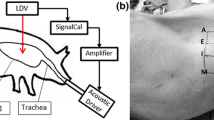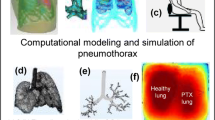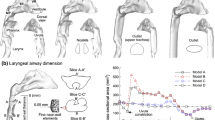Abstract
Chest physical examination often includes performing chest percussion, which involves introducing sound stimulus to the chest wall and detecting an audible change. This approach relies on observations that underlying acoustic transmission, coupling, and resonance patterns can be altered by chest structure changes due to pathologies. More accurate detection and quantification of these acoustic alterations may provide further useful diagnostic information. To elucidate the physical processes involved, a realistic computer model of sound transmission in the chest is helpful. In the present study, a computational model was developed and validated by comparing its predictions with results from animal and human experiments which involved applying acoustic excitation to the anterior chest, while detecting skin vibrations at the posterior chest. To investigate the effect of pathology on sound transmission, the computational model was used to simulate the effects of pneumothorax on sounds introduced at the anterior chest and detected at the posterior. Model predictions and experimental results showed similar trends. The model also predicted wave patterns inside the chest, which may be used to assess results of elastography measurements. Future animal and human tests may expand the predictive power of the model to include acoustic behavior for a wider range of pulmonary conditions.








Similar content being viewed by others
References
Acikgoz S, Ozer MB, Royston TJ, Mansy HA, Sandler RH (2008) Experimental and computational models for simulating sound propagation within the lungs. ASME J Vib Acoust 130(2):021010
Athanassiadi K, Kalavrouziotis G, Loutsidis A, Hatzimichalis A, Bellenis I, Exarchos N (1998) Surgical treatment of spontaneous pneumothorax: ten-year experience. World J Surg 22(8):803–806
Bohadana AB, Kraman S (1989) Transmission of sound generated by sternal percussion. J Appl Physiol 66(1):273–277
Bohadana AB, Patel R, Kraman SS (1989) Contour maps of auscultatory percussion in healthy subjects and patients with large intrapulmonary lesions. Lung 167(1):359–372
Bourbie T, Coussy O, Zinszner B (1987) Acoustics of porous media. Gulf Publishing Company, Huston, pp 86–87
Bourke S, Nunes D, Stafford F, Turkey G, Graham I (1989) Percussion of the chest re-visited: a comparison of the diagnostic value of auscultatory and conventional chest percussion. Iran J Med Sci 158(4):82–84
Dai Z, Peng Y, Royston TJ, Mansy HA (2013) Experimental comparison of poroviscoelastic models for sound and vibration in the lungs. ASME J Vib Acoust. doi:10.1115/1.4026436
Goll JH (1979) The design of broad-band fluid-loaded ultrasonic transducers. Son Ultrason IEEE Trans 26(6):385–393
Goss BC, McGee KP, Ehman EC, Manduca A, Ehman RL (2006) Magnetic resonance elastography of the lung: technical feasibility. Magn Reson Med 56(5):1060–1066
Guarino J (1974) Auscultation percussion: a new aid in the examination of the chest. J Kans Med Soc 75(6):193–194
Guarino J (1980) Auscultatory percussion of the chest. Lancet 315(8182):1332–1334
Hansen LB, Brons M, Nielsen NT (1986) Auscultatory percussion of the lung: prospective comparison of two methods of clinical examination of the lungs. Ugeskr Laeg 148(6):323–325
Kemper J, Sinkus R, Lorenzen J, Nolte-Ernsting C, Stork A, Adam G (2004) MR elastography of the prostate: initial in vivo application. In RöFo-Fortschritte auf dem Gebiet der Röntgenstrahlen und der bildgebenden Verfahren 176(8):1094–1099. © Georg Thieme Verlag KG Stuttgart, New York
Kruse SA, Rose GH, Glaser KJ, Manduca A, Felmlee JP, Jack CR Jr, Ehman RL (2008) Magnetic resonance elastography of the brain. Neuroimage 39(1):231–237
Manduca A, Oliphant TE, Dresner MA, Mahowald JL, Kruse SA, Amromin E et al (2001) Magnetic resonance elastography: non-invasive mapping of tissue elasticity. Med Image Anal 5(4):237–254
Mansy HA, Balk R, Royston TJ, Sandler RH (2002) Pneumothorax detection using computerized analysis of breath sounds. Med Biol Eng Comput 40(5):526–532
Mansy HA, Royston TJ, Balk RA, Sandler RH (2002) Pneumothorax detection using pulmonary acoustic transmission measurements. Med Biol Eng Comput 40(5):520–525
Mariappan YK, Glaser KJ, Hubmayr RD, Manduca A, Ehman RL, McGee KP (2011) MR elastography of human lung parenchyma: technical development, theoretical modeling and in vivo validation. J Magn Reson Imaging 33(6):1351–1361
Murray A, Neilson JMM (1975) Diagnostic percussion sounds: 1. a qualitative analysis. Med Biol Eng Comput 13(1):19–28
Napadow VJ, Mai V, Bankier A, Gilbert RJ, Edelman R, Chen Q (2001) Determination of regional pulmonary parenchymal strain during normal respiration using spin inversion tagged magnetization MRI. J Magn Reson Imaging 13(3):467–474
Ogata K (2004) System dynamics, vol 4, 4th edn. Pearson/Prentice Hall, New Jersey, p 107
Ozer MB, Acikgoz S, Royston TJ, Mansy HA, Sandler RH (2007) Boundary element model for simulating sound propagation and source localization within the lungs. J Acoust Soc Am 122(1):657–671
Plewes DB, Bishop J, Samani A, Sciarretta J (2000) Visualization and quantification of breast cancer biomechanical properties with magnetic resonance elastography. Phys Med Biol 45(6):1591
Rice DA (1983) Sound speed in pulmonary parenchyma. J Appl Physiol 54:1304–1308
Royston TJ, Dai Z, Chaunsali R, Liu Y, Peng Y, Magin RL (2011) Estimating material viscoelastic properties based on surface wave measurements: a comparison of techniques and modeling assumptions. J Acoust Soc Am 130(6):4126–4138
Royston TJ, Ozer MB, Acikgoz S, Mansy HA, Sandler RH (2008) Advances in computational modeling of sound propagation in the lungs and torso with diagnostic applications. In: Biomedical applications of vibration and acoustics in imaging and characterizations, chap 9. ASME Press, pp 217–248
Royston TJ, Zhang X, Mansy HA, Sandler RH (2002) Modeling sound transmission through the pulmonary system and chest with application to diagnosis of a collapsed lung. J Acous Soc Am 111:1931–1946
Venkatesh SK, Yin M, Ehman RL (2013) Magnetic resonance elastography of liver: technique, analysis, and clinical applications. J Magn Reson Imaging 37(3):544–555
Visible Human Project (2003) http://www.nlm.nih.gov/research/visible/visible_human.html
Von Gierke HE, Oestreicher HL, Franke EK, Parrack HO, von Wittern WW (1952) Physics of vibrations in living tissues. J Appl Physiol 4(12):886–900
Walker HK, Hall WD Hurst JW (1990) The funduscopic examination-clinical methods: the history, physical, and laboratory examinations, 3rd edn, Chaper 46, Butterworths
Warner L, Yin M, Ehman RL, Lerman LO (2009) Kidney stiffness measured in an animal model of unilateral renal arterial stenosis using 2-D MR elastography. in: Proceedings of the international society for magnetic resonance in medicine, p 407
Wodicka GR, Stevens KN, Golub HL, Cravalho EG, Shannon DC (1989) A model of acoustic transmission in the respiratory system. IEEE Trans Biomed Eng 36(9):925–934
Wodicka GR, Aguirre A, DeFrain PD, Shannon DC (1992) Phase delay of pulmonary acoustic transmission from trachea to chest wall. Biomed Eng IEEE Trans 39(10):1053–1059
Yasar TK, Royston TJ, Magin RL (2012) Wideband MR elastography for viscoelasticity model identification. Magn Reson Med 70(2):479–489
Acknowledgments
Financial support of the National Institutes of Health (Grant No. EB012142) is acknowledged. The assistance of Mr. Brian Henry in the experiment is appreciated.
Author information
Authors and Affiliations
Corresponding author
Rights and permissions
About this article
Cite this article
Peng, Y., Dai, Z., Mansy, H.A. et al. Sound transmission in the chest under surface excitation: an experimental and computational study with diagnostic applications. Med Biol Eng Comput 52, 695–706 (2014). https://doi.org/10.1007/s11517-014-1172-8
Received:
Accepted:
Published:
Issue Date:
DOI: https://doi.org/10.1007/s11517-014-1172-8




